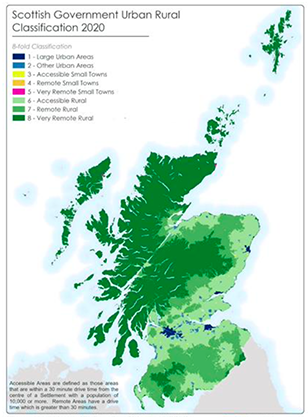Regional economic policy review: paper 1 – the national perspective
In this review the Regional Economic Policy Advisory Group examine why, and in which policy areas, economic development works well on a regional scale, assessing how its delivery can contribute to the aims of the National Strategy for Economic Transformation.
6. Economic Policy Metrics: NSET, SHRED and Benefits Realisation
6.1 Scotland's Index of Multiple Deprivation
6.1.1 In Scotland, the Scottish Index of multiple Deprivation (SIMD) is used to measure relative deprivation within and across regions. This Index is now on its third iteration, by assessing spatial inequality through 7 lenses of income, employment, health, service assess, crime and housing.
6.1.2 SIMD has split Scotland into 6,976 small areas (data zones) with roughly equal population; these areas are then assessed based on 30 indicators of deprivation including travel time to a GP, unemployment and crime statistics. It can help improve understanding about the outcomes and circumstances of people living in the most deprived areas in Scotland. It can also allow effective targeting of policies and funding where the aim is to wholly or partly tackle or take account of area concentrations of multiple deprivation. SIMD is an area-based measure of relative deprivation: not every person in a highly deprived area will themselves be experiencing high levels of deprivation.
6.1.3 Despite the use of these metrics, there are some conceptual and practical concerns in their applicability to rural areas. With data zones across sparsely populated rural areas being larger in size this, in turn, creates a mixed picture of people experiencing different levels of deprivation. This means that SIMD is less helpful at identifying the smaller pockets of deprivation found in more rural areas, compared to the larger pockets found in urban areas.[56]
6.2 Wellbeing Monitor
6.2.1 The Scottish Government Wellbeing Economy Monitor[57] was launched in June 2022 as a key part of NSET, developed to look beyond GDP to measure how Scotland's economy contributes to improving things that people really value, such as health, equality, fair work and environmental sustainability.
6.2.2 The data contained will be used alongside the National Performance Framework to guide future economic decision making, helping to deliver a just transition to a net zero, nature-positive, circular, wellbeing economy based on the principles of equality, sustainability, prosperity and resilience; all of which are vital to the nature of how the Scottish Government aim to transform the economy.
6.2.3 Given the limitations of SIMD noted above, REPAG note that it would be beneficial to examine further how a needs-based allocation based on a variety of measures, that better reflects the nuances of different regions, might look, and work with OCEA to ascertain how this might play into Scottish Government's Wellbeing Economy ambitions.
6.3 Scottish Government Urban Rural Classification 2020
6.3.1 Scottish Government uses the terms Rural, Remote Rural, Accessible Rural and Islands when setting out and considering how policies, strategies, services and legislation affect and impact upon communities across the 32 council areas e.g. Island Communities Impact Assessments. The intention is to provide a consistent way of defining urban and rural areas across Scotland[58]. The classification is based upon two main criteria: population and accessibility.
6.3.2 The classification is available in multiple forms, including a 6-fold classification which distinguishes between urban, rural, and remote areas through six categories, and an 8-fold classification which further distinguishes between remote and very remote regions. By combining both the population and accessibility measures, a Scotland-wide Urban Rural Classification is defined.

6.4 Measuring and Monitoring Success
6.4.1 Measuring the impact of an initiative varies across policies and over time, with a move away from the traditional economic measures of progress and development. Scotland's National Performance Framework offers a quantitative and qualitative update on progress towards the achievement of goals but it doesn't advise on the impact of a specific initiative.
6.4.2 There is value in examining the potential in taking this approach when assessing the output of regional economic policy, noting that efforts are being made within the Deals programme to do precisely this in their Benefits Realisation work. Extending this across all Scottish Government investments within regions would entail that the success of regional policy could be based a holistic set of metrics, going beyond GDP to determine how Scotland's wellbeing is being impacted by various interventions. Again, this ought to be considered in the light of the Wellbeing Economy Monitor, to determine how Scotland's wellbeing is being impacted by various interventions.
6.4.3 This note on measuring success would help to link regional economic development with the strategies being implemented at a national level such as the NSET. Regional is not the only operating level, and some aspects of policy function much better at national and local levels. The goal here should therefore be greater alignment between local, regional and national to ensure consistent levels of success. There will always be a requirement for national action (for policy matters which cross regional boundaries or are relevant across an individual's whole life cycle) and meeting very specific local needs.
Contact
Email: rachel.phillips@gov.scot
There is a problem
Thanks for your feedback